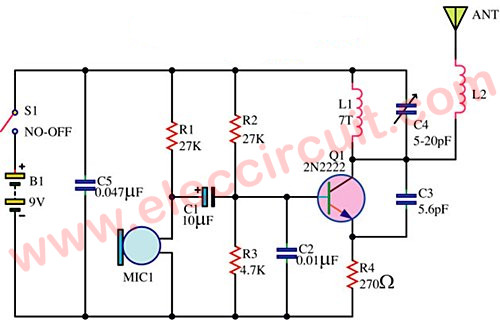Monday, 25 March 2013
FM wireless transmitter circuit
How it work
When we speak, the microphone will receive the audio signal is mixed with range FM frequency to transmit the broadcast spectrum. The audio input is just bring to the FM radio receiver tuned provide the radio only. The detailed procedures are as follows.
In Figure this circuit has very little equipment, MIC is used in the circuit be special that called the condenser microphone, inside the MIC has an one amplifier section Serves to amplify the voice that speaks to the strength increases and send to the output. So this MIC must a current one to them. Please note the circuit is supplied to the resistor 27K positive in the leg microphone,and it is way out of with the audio signal,through the coupling capacitor to pin B of Q1,

Which Q1 also acts as both the radio frequency generator and the audio mixer on the Radio frequency is generated. and at B pin of the Q1 have the resistor R2 – 27K with R3 – 4.7K are divider circuit, Divided a number of voltage to the bias for Q1. and the capacitor C2-0.01uF is connected to ground for bypass the high frequency, At C pin of the Q1 is connected pass the coil to the positive voltage
For this coil, we use copper wire No. 19-20 AWG, wrapped around the air core diameter of 7 mm. You should be bind seven around , similar to coil spring, Then, stretching out to Length of 15 mm. close this coil has a capacitor C4 value 5-20pF is the capacitor to adjust from 5pf to 20pF we called that the timmer. It is connected to a frequency tuning
And pin C of Q1 is connected to the antenna. Which in this circuit, we use an antenna that is built with yourself. By using number of wire 16-20 AWG, about 7 inches in length, and curled into a circle like a spring, about 6 mm in diameter, the length of the wire coil to the the end, then take one end soldered to the antenna connection.
Creating and use
You should be include before small device. The condenser MIC should be use the shielded cables in length about 5 cm to connect from the PCB. We use the coated copper wire for to prevent rust green from moisture in the air. At the end of the wire must be soldered, the need for razor blade to scrape out a solution. so is soldered on. The use of lead solder, lead to a better mix of 60/40, and requires some skill in soldering. Otherwise, the spectrum could not be removed. It is a high frequency.
When completed, the FM radio is one, open to the FM radio dial in the middle. When turn on the FM wireless transmitter circuit then use a screwdriver plastic or plastic sheet flat spin adjust the trimmer And speak into the microphone, to tune until has the sound to the FM radio. if tune the trimmer until full cycles, Not yet match wave, try stretching or shrinking of the coil, then adjust the new one, maybe try some stretching or shrinking the antenna, in order to deliver the best results. If all the fine tuning do still does not work. Also, try turning the radio waves, may be rotated to the minimum frequency, maximum frequency, or turn around the station. Then try adjust it again. When adjust until available, they may be find a plastic boxes or aluminum boxes or a box ready to build up own. By folding a sheet of aluminum or a plastic sheet is glued to the box for convenience to you.
Note: Principle, this circuit send far about 100 meters, Depending on the location. There is low or high of noise oscillator, Equipment with high quality or not, The soldering is good or not, Therefore, it is difficult to determine how far? But from my experience, in the center of the floor to the fourth floor of the building, it has been, they think that’s enough for the circuit with very little equipment, and low cost of this.
Labels:
circuit,
fm,
transmitter,
wireless
Subscribe to:
Post Comments (Atom)
No comments:
Post a Comment
Note: only a member of this blog may post a comment.